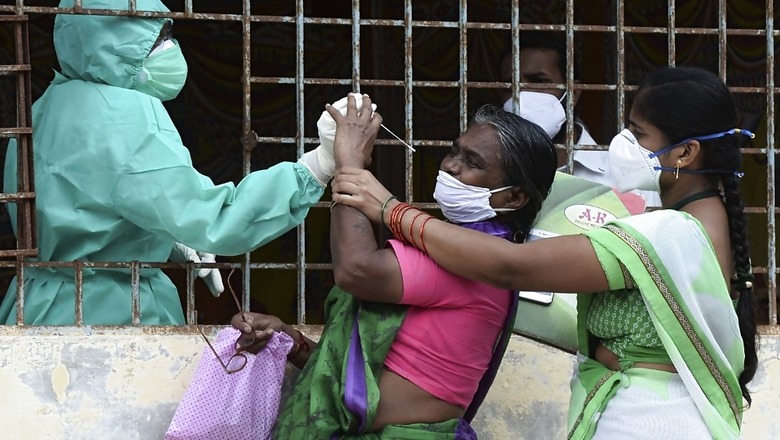
views
While Indian cities have been at the receiving end of the Covid-19 pandemic in terms of infection loads (10 cities accounting for half of Covid-19 cases), these engines of economic growth are also worst impacted due to pandemic-induced disruptions. City dwellers particularly the poor informal sector workers have taken the maximum brunt of the pandemic. Lockdowns, social distancing norms, shutting down of markets, factories and allied activities have paralyzed the work opportunities for these sections of urban populations. Urban unemployment which was in stress sharpened further during the initial weeks of pandemic. Prolonged lockdowns and associated restrictions tripled urban unemployment in March and April. It needs to be mentioned that a vast majority of urban population work in unorganized (informal) sector of the economy with irregular salaries, no written job contracts, often get their jobs through job contractors and subcontractors with no social protection. Of the estimated 80 million urban poor, nearly 80 per cent work in firms that often lack social security programs like Employees’ Provident Fund and State insurance funds, which are being channeled to extend relief to these population during the lockdown. At least in rural areas, people have some assets like land and livestock to fall back during a crisis situation like the Covid-19, but urban informal workers have nothing of that kind. Thus, in a sense urban poor are nowhere people when work and economy are literally shut.
State response to Urban Poor
As the pandemic began spreading its tentacles first in major cities and towns, both Centre and States were quick to announce a number of initiatives in the forms of cash transfers, food ration, temporary shelters apart from enlarging the existing flagship programs to lessen the hardship. The Union government announced an immediate 1.7 lakh crore economic package (for both rural and urban populations) under the existing Prime Minister Garib Kalyan Yojana (PMGKY) to ensure free food (through Prime Minister Garib Kalyan Anna Yojana or PMGKAY) and a limited cash transfer support were extended to the most vulnerable citizens many of them residing in urban areas. For instance, cash transfers included Rs.1000 to be provided to nearly 30 million poor pensioners, widows and disabled and a Rs.500 monthly deposit to be made to 200 million women holding Jan Dhan accounts (both components for a period of 3 months). Beyond cash, the government extended food rations to 800 million beneficiaries registered under the National Food Security Act. Further, to reach out the urban poor, the government extended a free grain entitlement of 5kg rice/wheat per person and 1kg chickpeas per household to an estimated 80 million migrants (who are not covered under National Food Security Act or State Public Distribution System).
In the second tranche of economic relief package announced in June, the Union government launched a number of tailor-made schemes to address the woes of urban poor. Among these was the easy access to credit provision for street vendors who were to be provided with an initial working capital of up to Rs 10,000 to restart businesses that took the brunt of the lockdown. The intervention aimed at supporting 50 lakh such vendors and providing liquidity up to Rs 5000 crores.
Given access to housing remains a major concern for urban poor especially the migrant workers, affordable rental housing scheme was curated under the existing flagship program the Prime Minister Awas Yojana. The idea was to convert government-funded housing in cities to rental complexes through public-private partnerships. Additionally, efforts were made to generate employment opportunities for the urban poor during the pandemic through Self Help Groups (SHGs) that can produce face masks and hand sanitizer. Beyond the Centre, most state governments have launched their programs and initiatives to lessen the hardships of urban poor and migrant workers. In fact, states like Kerala, Odisha, Tamil Nadu, Telangana were far more proactive than the Centre on this. For instance, Odisha announced the Urban Wage Employment Initiative for urban informal labour to carry out works identified by the Urban Local Bodies.
A reality check
Government Schemes and handouts have come as a big relief for a chunk of urban poor who could access these benefits. The Central housing scheme in particular is sustainable measure to address perennial crisis of affordable housing in cities. However, based on the reports of concerned ministries, still a large section of these marginalized population is found to be out of reach of these schemes. The Ministry of Consumer Affairs, Food and Public Distribution report shows that only 33 per cent of free food grains and 56 per cent of free gram (whole) for migrants under the Atma Nirbhar Bharat package have reached the intended population. Similarly, of the 8 lakh tonnes of food grains earmarked for the migrant workers, 6.38 lakh tonnes (80 per cent) was lifted by the states and UT, but only 2.64 lakh tonnes (33 per cent) have been distributed among the targeted beneficiaries in the last four months. Beyond food grains, there are major bottlenecks in disbursements of loans and financial supports meant for poor urban dwellers like small shopkeepers/SHGs. According to a recent report quoting data of the Ministry of Finance (released during Parliament session), only 7.3 percent of the 50 lakh beneficiaries had received loan approvals and of that, the loans were disbursed to 99,000 beneficiaries.
These trends of poor utilization of well-intentioned schemes have been further corroborated by some recent studies. For instance, according to a recent study undertaken by the London School of Economics (Centre for Economic Performance), notwithstanding multiple schemes and handouts extended by various governments, as much as 52 percent of urban workers in India went at least a month without work or any financial assistance during the lockdown. Among these, the informal workers were least likely to receive any assistance either from the government or their employers. The study that used inputs from 8500 workers from different cities between May and July also observed that incomes of the workers dropped by 48 percent between January-February and April-May 2020 and that 80 percent of informal workers were unemployed for over a month as compared to only 20 percent in the formal sector. It also found that financial assistance from the governments or employers could reach only a quarter of the workforce, leaving rest of them to survive on penury or handouts provided by charities and non-governmental organizations (NGOs). Another recent study accounted poor outcomes of these schemes to lack of awareness and necessary documents to access these state benefits. While the Centre has launched inter-state portability of ration cards in June keeping in mind migrant workers living in urban areas, it is still a work in progress and not an adequate answer to the pandemic related crises.
Way forward
A quick review of urban poor particularly the informal sector workers leaves little doubt about their precarious conditions notwithstanding a plethora of schemes and certain handouts from multiple institutions. As data from CMIE shows the pandemic induced lockdown has devasted nearly all major sectors of the economy including the organized sector. Although there is some uptick after lockdown restrictions have been eased, it will still take a long time for normalcy to arrive. A number of urban occupations that employs large percentage of urban poor such as domestic help, bus conductors, street vendors, sex workers, band performers have still a long and tough road ahead. As an example, take the case of roughly 20 million domestic workers who are low paid, work without any contract or any social security. A vast majority of them still go without their regular works and the state sponsored handouts would hardly redress the loss of their critical daily incomes.
This makes it imperative to think about sustainable measures beyond handouts or similar initiatives. The urban workers need something equivalent to the rural job scheme (Mahatma Gandhi National Rural Employment Guarantee Act or MGNREGA) that promises 100 paid workdays worth of rural employment to its beneficiaries. As has been extensively reported, the often derided rural job scheme has come as a huge safety net for millions of rural poor including returnee migrants in the time of pandemic. To illustrate the efficacy of the program, in May alone, a record 417.7 million person-days of work was created under MGNREGA, while the number of households covered under the job scheme went up by 31% in May to 28 million, highest ever numbers for a month since the scheme was launched in 2007. The Union government is actively considering to launch something similar to MGNREGA for the urban poor that can act as a ‘fallback employment’ option. However, urban workforce requirements and skills set are different. This essentially means the job scheme have to be curated differently and imaginatively.
While there are no equivalents of MGNREGA (which was modelled on years of experience of drought relief works in Rajasthan) in urban areas for designing the new scheme, some critical insights can be drawn from state level experiences. Economist Jean Dreze has listed the examples of Kerala’s Ayyankali Urban Employment Guarantee Scheme across its urban local bodies since last 10 years. Like MGNREGA, Kerala urban job scheme has generated as many as 27 lakh person-days in 2019-20. Taking cues from Kerala experience, Jean Dreze has proposed an innovative idea called Decentralised Urban Employment and Training or DUET which can be in the form of ‘job stamps’ issued by governments and distributed among approved public institutions such as schools, colleges, shelters, museums, jails, municipalities among others to convert each stamp to a person-day. In this regard, Jean Dreze cites the examples of a number of European countries that are currently engaged in DUET like employment-subsidy with some successes. Of course, the government of the day has to take a careful and objective assessment of many issues including financial and administrative feasibility before it takes a call on this. However, there is growing unanimity among policy makers and subject experts that the urban India needs jobs or income schemes to that can act as a fallback option in the time of major crises.
The article has been co-authored by Megha Biswas, Research Intern at ORF.




















Comments
0 comment